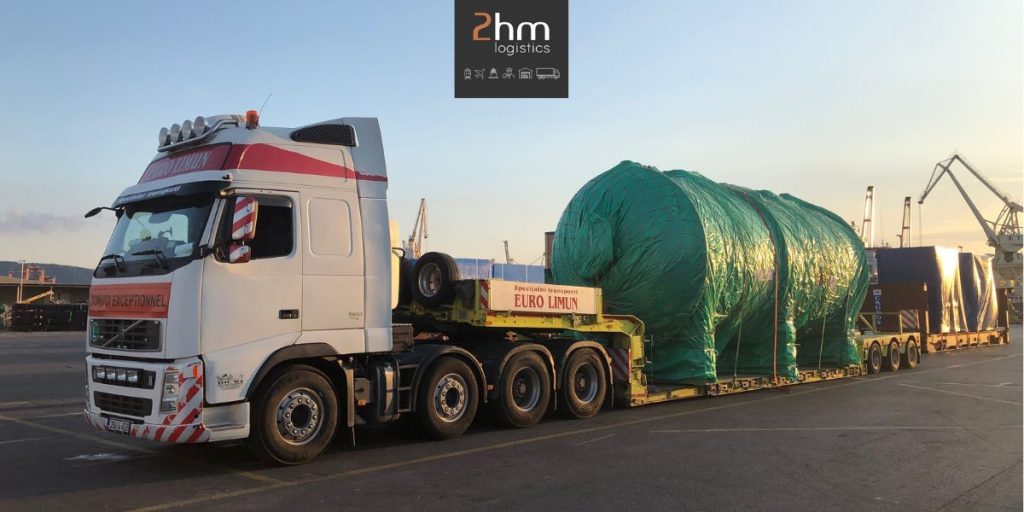Out of Gauge (OOG) freight services refer to the transportation of cargo that does not fit into standard shipping containers. This type of cargo is typically oversize or overweight. It may require special handling and equipment in order to ship safely. At 2hm logistics we have the experience and expertise to handle any OOG shipment, no matter how challenging. We will work with you to develop a shipping solution that meets your specific needs. Additionally, we will ensure that we transport your cargo safely and efficiently. Contact us today to learn more about our out of gauge cargo services.

What is OOG Freight?
There is no definitive answer to this question. The definition of out of gauge cargo can vary depending on the shipping company or carrier. In general, OOG cargo is any shipment that does not fit into a standard 20-foot or 40-foot shipping container. This type of cargo is typically oversize or overweight. The out of gauge cargo may require special handling and equipment in order to ship safely.
Out of Gauge Cargo Examples:
Heavy Machinery
Industrial equipment exceeding standard size and weight limits.
Construction Materials
Oversized materials like steel beams and concrete elements for infrastructure projects.
Oversize Vehicles
Large vehicles such as cranes and tractors that surpass regular container dimensions.
Bulk Commodities
Vast quantities of raw materials like ores and timber, requiring specialized handling.
Request a Quotation
Out of Gauge (OOG) Freight Costs
Understanding the costs of out of gauge (OOG) freight is essential for businesses aiming to effectively manage their shipping budgets. Prices can vary widely based on the cargo’s dimensions, weight, and the required logistics to safely transport it to its destination. These costs can include, but are not limited to:
- Special handling fees
- Additional equipment rentals
- Potential route changes to accommodate the oversized load
At 2hm Logistics, we pride ourselves on offering transparent cost estimates. We ensure that our clients can make informed decisions about their OOG shipments.
Import info about your shipment
Providing detailed and information about your out of gauge (OOG) shipment is crucial for ensuring safe and efficient transport. It enables us to select the appropriate equipment, plan optimal routes, and manage any special handling requirements.
Overview of the OOG cargo
When shipping OOG cargo, it is important to provide accurate and accurate description about the shipment. This information will help determine the necessary equipment and route planning for safe transportation.
Weight of the OOG cargo in kilograms
The weight of OOG cargo is a crucial factor in determining the cost and logistics of shipping. It is important to accurately measure and provide the weight of the cargo in kilograms. This will affect the type of equipment needed for transportation.
Dimensions (longest length x broadest width x tallest height)
The dimensions of OOG cargo are also a key factor in determining the cost and logistics of shipping. Accurate measurements of the longest length, broadest width, and tallest height ensure proper planning for transportation.
Technical diagrams
For uniquely shaped or complicated OOG cargo, providing technical diagrams helps clarify how it should be transported. These diagrams can also help identify any needed changes or special handling requirements.
Any special handling or equipment requirements
OOG cargo may require special handling or equipment such as cranes, forklifts, or flatbed trailers for safe transportation. It is important to inform your logistics provider of any special requirements for your shipment.
Destination and delivery details
Providing precise destination and delivery details helps us find the most efficient and affordable route for your OOG shipment. This information should include the final delivery address, access points, and any potential obstacles that may arise.
Projected deadlines
Deadlines are an important aspect to consider when shipping OOG cargo. It is important to provide projected deadlines so that we can plan for the most efficient and timely delivery.
Additional Costs and Transit Time
Be aware that OOG cargo typically incurs additional fees or surcharges. This is due to the use of specialized equipment, extra insurance, or the need for special permits. These factors can also extend transit times, which you should account for in your planning.
Operational Activities Involved in OOG Freight
There are many operational activities associated with the transport of out of gauge cargo. These activities can vary depending on the specific shipment, but may include:
Obtaining permits and approvals: Often necessary for OOG cargo to ensure hassle-free transport.
Securing insurance coverage: Special handling of OOG cargo incurs extra fees, for additional insurance.
Arranging special handling: Requires flatbed trucks, cranes, or lowboys for safe shipping.
Coordinating with multiple parties: Essential for managing the various stakeholders in the shipment.
Monitoring the shipment: Important to ensure the cargo is transported correctly throughout the process.
Monitoring Out of Gauge Shipment
Monitoring an out of gauge shipment is a crucial part of the operational activities associated with this type of cargo. This involves tracking the shipment from its point of origin to its final destination. The monitoring allows us to transport your cargo safely and in accordance with all necessary requirements.

One way to monitor an OOG shipment is through the use of GPS or tracking technology. This allows for real-time updates on the status and location of the cargo. Thanks to this we can identify any potential issues or delays. In addition, communication with our dedicated account managers and transport specialists can provide further updates. We promptly address any concerns or questions that may arise during the shipping process.
2hm logistics Certifications
At 2HM Logistics, our dedication to excellence is not just a promise—it’s certified. Our array of prestigious certifications includes:
- ISO 14001:2015
- ISO 9001:2015
- IATA
- AEO
- HACCP
Important Information

Customs Clearance
Official authorization for cargo entry/exit.





Networks
We are a member of many logistics networks.





Weight Measurement
Essential for calculating freight transportation costs.





Warehousing
9000m² of owned space for optimized storage.
Different Container and Trailer Types for Out of Gauge Cargo
There are a variety of different types of containers that can be used to ship out of gauge cargo. These include:
Open Top Containers
Open Top Containers offer a versatile solution for shipping out of gauge cargo that is too tall for standard containers. These containers come with a removable top, which is often replaced by a tarpaulin to protect the goods from external elements during transport. This design not only facilitates the loading and unloading of bulky items but also accommodates goods that require vertical space beyond the confines of traditional container walls.
Flat Rack Containers
Flat rack containers are pivotal in the transport of out of gauge (OOG) cargo, providing a versatile and robust solution for items that don’t fit within the dimensions of standard shipping containers. Featuring a flatbed design with high load capacity, these containers are available with or without walls on the sides, which are sometimes collapsible. This flexibility makes them ideal for heavy machinery, construction materials, and large vehicles.
RoRo Solutions
For out of gauge cargo that cannot be shipped in a traditional container, there are RoRo (Roll on/ Roll off) Solutions available. This method involves loading the cargo onto specialized trailers and securing them on board a RoRo vessel. This is often used for oversized or heavy equipment such as construction machinery, large vehicles, and other bulky items.
Step deck trailers
These trailers have a step deck design that allows for the shipment of taller items that may not fit on a flatbed trailer. They have a lower deck height in the front and back, with a higher deck in the middle, allowing for more clearance. This design also enables them to carry taller cargo while maintaining the stability and balance of the load.
RGN trailers
RGN trailers are specialized trailers that have removable gooseneck ramps. These ramps allow for the easy loading and unloading of heavy cargo. They also have a lower deck height, making them suitable for taller out of gauge cargo. RGN trailers are a popular choice for transporting heavy machinery and equipment in the construction, mining, and agriculture industries.
Extendable trailers
Extendable trailers have a extendable bed that can be lengthened or shortened as needed. This allows for the shipment of cargo that may be too long or too short for a standard trailer.
As you can see, there are a variety of different types of containers that can be used to ship OOG cargo. Each type of container has its own advantages and disadvantages, so it is important to choose the right type of container for your specific needs. Our dedicated transport specialist will be happy to aid you during this process.
Related Questions
There are a variety of different types of containers that can be used to ship out of gauge cargo. These include: Flatbed trailers, Step deck trailers, RGN trailers, Extendable trailers.
The open top is the space on a container that is not covered by a roof. This space can be used to ship tall items that would not fit in a standard shipping container.
RGN trailers are specialized trailers that have removable gooseneck ramps. These ramps allow for the easy loading and unloading of heavy cargo.
Why 2hm logistics
- Full-Service Logistics: Providing logistics services across all modes of transport. Covering your whole logistics agenda.
- Certified Excellence: Holding ISO 14001, ISO 9001, AEO, HACCP and IATA certifications.
- Transparent Pricing: What we quote is what we build. No hidden fees or last-minute additions.
- Part of Neele-Vat Family: Thanks to partial acquisition, we offer an expanded European network and support of a strong partner.
- Port of Koper: Headquatered at the key European gateway providing fiscal representation and robust rail network.
- Personalized Support: Dedicated account manager ensures a uniquely personal touch, beyond the usual broad approach.
- Local and Logistical Expertise: Deep understanding of regional logistics and customs, along with profound industry knowledge.
- Warehouse Solutions: Over 9,000 m² of warehousing facilities with value added services.
